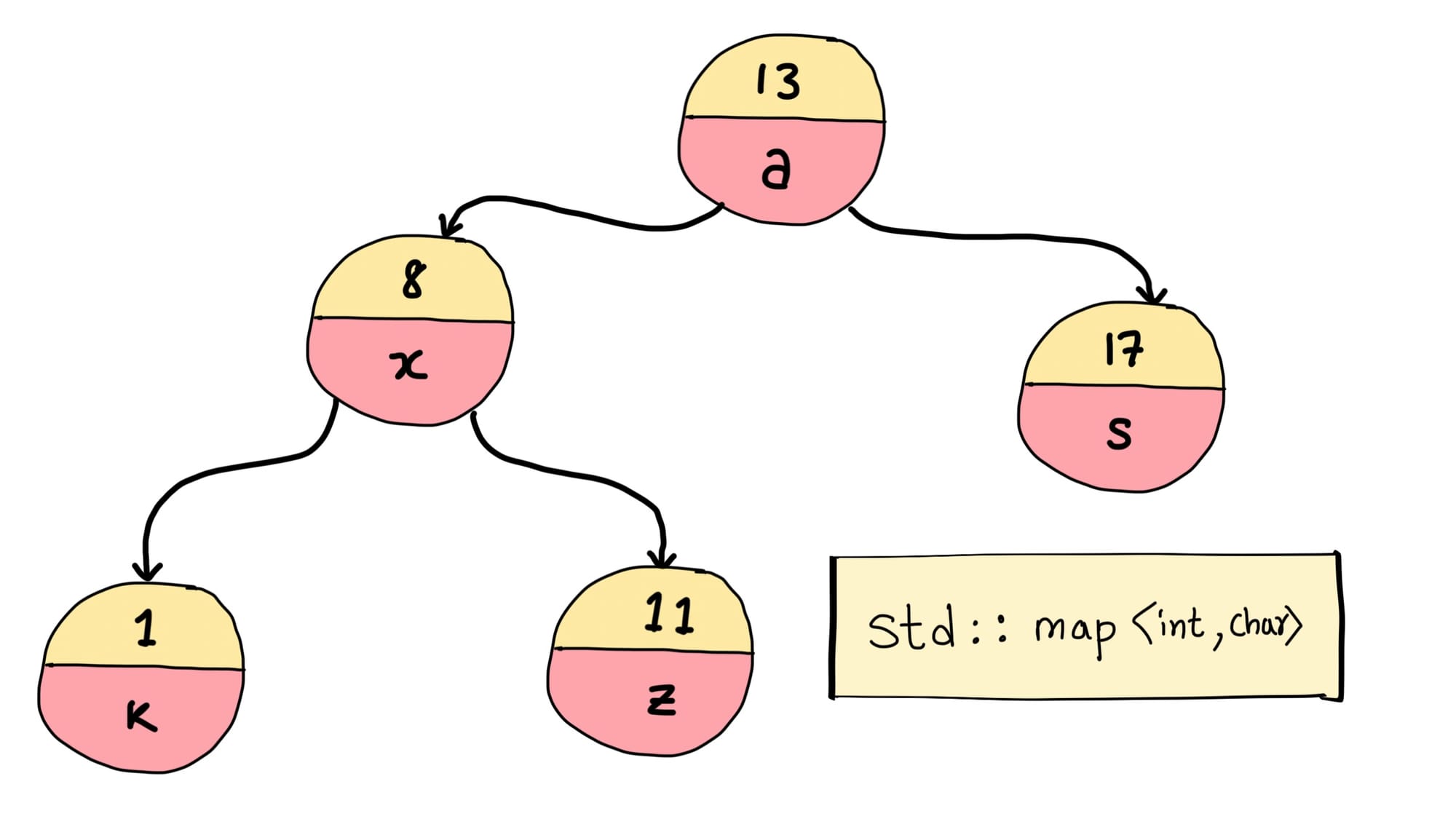std::map in C++
std::map is an associative container that stores elements in key-value pairs. Each key in a std::map is unique, and each key is associated with exactly one value. This container provides fast retrieval of values based on their keys.

Introduction to std::map
C++ is a powerful programming language known for its versatility and efficiency. One of its most valuable components is the Standard Template Library (STL), which includes std::map, a dynamic associative container. This container allows for the storage and quick retrieval of key-value pairs, making it an essential tool for many programming tasks.
What is std::map?
std::map is an associative container that stores elements in key-value pairs. Each key in a std::map is unique, and each key is associated with exactly one value. This container provides fast retrieval of values based on their keys.
Key Features of std::map
- Associative Container: Stores elements in key-value pairs.
- Unique Keys: Each key in the map is unique.
- Automatic Sorting: Keys are automatically sorted.
- Efficient Lookup: Fast retrieval of values based on keys.
- Balanced Binary Tree: Typically implemented as a balanced binary tree (e.g., red-black tree).
How to Declare and Initialize a std::map
Here are some basic ways to declare and initialize a map:
#include <iostream>
#include <map>
int main() {
std::map<int, std::string> map1; // Empty map with integer keys and string values
std::map<int, std::string> map2 = {{1, "one"}, {2, "two"}, {3, "three"}}; // Map initialized with key-value pairs
return 0;
}
Basic Operations on std::map
Adding Elements
Elements can be added to the map using the insert method or the [] operator:
map1.insert({4, "four"}); // Adds key-value pair {4, "four"}
map1[5] = "five"; // Adds key-value pair {5, "five"}
Accessing Elements
Elements in a map can be accessed using the [] operator or the at method:
std::string value = map2[1]; // Access value associated with key 1
std::string value2 = map2.at(2); // Access value associated with key 2 (with bounds checking)
Removing Elements
Elements can be removed from the map using the erase method:
map1.erase(4); // Removes element with key 4
Iterating Over Elements
You can use a range-based for loop or an iterator to iterate over the elements of a map:
for (const auto& pair : map2) {
std::cout << pair.first << " -> " << pair.second << std::endl;
}
for (std::map<int, std::string>::iterator it = map2.begin(); it != map2.end(); ++it) {
std::cout << it->first << " -> " << it->second << std::endl;
}
Real-World Examples of std::map
Example 1: Storing Student Grades
Imagine you are developing a program to manage student grades. You can use std::map to store and manage the grades of students based on their ID numbers.
#include <iostream>
#include <map>
#include <string>
int main() {
std::map<int, std::string> studentGrades;
// Adding student grades
studentGrades[101] = "A";
studentGrades[102] = "B";
studentGrades[103] = "C";
// Displaying student grades
for (const auto& pair : studentGrades) {
std::cout << "Student ID: " << pair.first << ", Grade: " << pair.second << std::endl;
}
// Updating a student's grade
studentGrades[102] = "A";
// Displaying updated grades
for (const auto& pair : studentGrades) {
std::cout << "Student ID: " << pair.first << ", Grade: " << pair.second << std::endl;
}
return 0;
}
Example 2: Word Frequency Counter
Suppose you are working on an application that analyzes text to count the frequency of each word. You can use std::map to store the word frequencies.
#include <iostream>
#include <map>
#include <string>
#include <sstream>
int main() {
std::map<std::string, int> wordCount;
std::string text = "hello world hello C++ world";
// Split text into words and count their frequency
std::stringstream ss(text);
std::string word;
while (ss >> word) {
wordCount[word]++;
}
// Display word frequencies
for (const auto& pair : wordCount) {
std::cout << pair.first << " -> " << pair.second << std::endl;
}
return 0;
}
Advanced Operations on std::map
Finding Elements
You can find an element in a map using the find method:
std::map<int, std::string>::iterator it = map2.find(2);
if (it != map2.end()) {
std::cout << "Found: " << it->first << " -> " << it->second << std::endl;
} else {
std::cout << "Key not found" << std::endl;
}
Counting Elements
The count method returns the number of elements with a specific key (0 or 1 for std::map):
int count = map2.count(2); // Returns 1 if key 2 is present, otherwise 0
Getting the Size of the Map
The size method returns the number of elements in the map:
size_t mapSize = map2.size(); // Returns the number of elements in map2
Clearing the Map
The clear method removes all elements from the map:
map2.clear(); // Removes all elements
Common Pitfalls and Best Practices
Avoid Using [] for Non-Existent Keys
Using the [] operator to access a non-existent key will insert a new key-value pair with a default value. Use find or count to check for the existence of a key before accessing it:
if (map2.find(6) != map2.end()) {
std::string value = map2[6];
} else {
std::cout << "Key not found" << std::endl;
}
Use const Correctly
When iterating over or accessing elements of a map that should not be modified, use const to prevent accidental changes:
void printMap(const std::map<int, std::string>& map) {
for (const auto& pair : map) {
std::cout << pair.first << " -> " << pair.second << std::endl;
}
}
Choose Appropriate Key Types
The key type should be chosen carefully to ensure efficient comparison and sorting. Avoid using complex or expensive-to-compare types as keys.
Conclusion
std::map is a powerful and flexible container in C++ that allows you to manage key-value pairs efficiently. By understanding and utilizing the basic and advanced operations of std::map, you can write more efficient and maintainable C++ programs. Whether you are storing student grades, counting word frequencies, or handling any other associative data, std::map is an invaluable tool in your C++ toolkit.
Summary of Key Points
- Associative Container:
std::mapstores elements in key-value pairs. - Unique Keys: Each key is unique within the map.
- Efficient Lookup: Provides fast retrieval of values based on keys.
- Automatic Sorting: Keys are automatically sorted.
- Versatility: Suitable for a wide range of applications, from simple to complex.
By mastering std::map, you will enhance your ability to handle associative data structures in C++, preparing you for more complex programming challenges. Happy coding!

Discussion